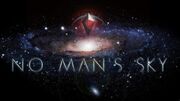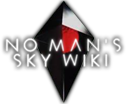| The subject of this article is from the Singularity update.
The information from this article is up-to-date as of 23 August, 2023. |
The information from this article is up-to-date as of 23 August, 2023.

The universe is the largest named object in No Man's Sky.
Summary[ | ]
The universe of No Man's Sky comprises 256 unique galaxies. In turn, these are composed of:
- 4.2 billion regions (the limit of a 32 bit integer)
- each of which contains more than 122 and up to roughly 642 star systems
All star systems feature from 2-6 planets and moons, and usually a single space station.
There are about 18 quintillion possibilities (seeds) for planets (the limit of a 64 bit integer), however not all are currently in use. There are an estimated 2 quadrillion planets accessible in vanilla play.
Permutation[ | ]
Different game modes play in different permutations of the universe. The different platforms have the same permutation. Please note the below coding for these are not official terms.
Steam[ | ]
The Steam version of the game automatically updates when one is released.
| Permutation | Game mode | Platform |
|---|---|---|
| Universe "E" | Expeditions | PC / PS4 / Xbox / Switch / Mac |
| Universe "P" | PermaDeath | PC / PS4 / Xbox/ Switch / Mac |
| Universe "R" | Normal, Creative, Relaxed, Survival, Custom | PC / PS4 / Xbox / Switch / Mac |
GOG[ | ]
The GOG version of the game allows a player to roll back to previous updates until NEXT 1.60 [1], which makes permutations for the universe to each update.
| Permutation 1 | Game mode | Platform | Update 1 |
|---|---|---|---|
| Universe "C-1.XX" | Creative | PC / PS4 / Xbox | 1.XX |
| Universe "N-1.XX" | Normal | PC / PS4 / Xbox | 1.XX |
| Universe "S-1.XX" | Survival | PC / PS4 / Xbox | 1.XX |
| Universe "P-1.XX" | Permadeath | PC / PS4 / Xbox | 1.XX |
1 Where XX means the update coding, see the patch notes.
Regeneration[ | ]
During a universe regeneration, the player will not lose their inventory items, bases, or starships. The procedurally generated objects will have a new name and different stats, but their class remains.
If any object is removed from the game, it will be removed from the player's inventories as well. It may be replaced by a newly introduced object to render it obsolete, such as the Obsolete Technology used in NEXT.
Sometimes certain objects will not be removed, but simply became unobtainable (see the Atlas Stone).
Universe Evolution[ | ]
In the beginning of the Foundation era, there were distinct universes of discoveries. With the exception of player applied names upon discovery and bases, all other details were the same across universes. There was one universe for each game mode on each platform, so a total of 12 parallel universes. (Three platforms, four game modes each).
During the evolution from Pathfinder to Atlas Rises, the region and system names changed, and some discoveries were reset across all universes. Further changes occurred throughout the updates to the simulation, but the next major change was from the Expeditions era update, which consolidated all of the 12 parallel universes into one integrated universe, allowing travellers from any platform to see discoveries, naming and bases from any other platforms players.
For more information, see Universe Evolution.
Release history[ | ]
- Release - Introduced to the game.
- Release 1.03 - Changed the rules of the universe generation algorithm. Planets have moved. Environments have changed biomes. Galaxies have altered shape. All to create greater variety earlier. Galaxies are now up to 10x larger.
- Pathfinder - The universe experienced a limited regeneration.
- Atlas Rises - The universe experienced a large-scale regeneration. The 256th galaxy and subsequent ones were removed from the universe; they cannot be reached through normal gameplay any longer. Now the 255th galaxy leads back to the 1st. To prevent players getting stuck in higher numbered galaxies, those lead back the lowered numbered galaxies: 256th leads to 2nd, 257th leads to 3rd etc.
- NEXT - The universe experienced a regeneration.
- Abyss - The universe experienced a limited regeneration by the addition of new underwater biomes. Also the artifacts experienced a small-scale regeneration.
- Visions - The universe experienced a limited regeneration by the addition of new exotic biomes.
- Beyond - The universe experienced a limited regeneration by converting Dead biomes into Exotic ones due to a coded property.
- Crossplay - removed the crossplay restriction between platforms.
- Origins - Universe experienced a major regeneration and new planets were generated.
References[ | ]
- ↑ Is it possible to roll back to Atlas Rises?, User japp_02 on Steam, dated 22 September 2018.
